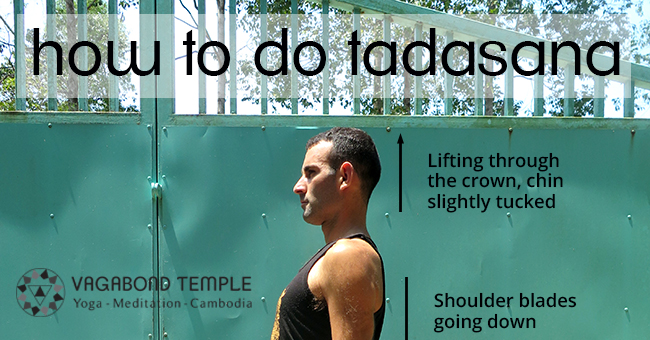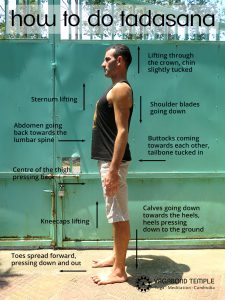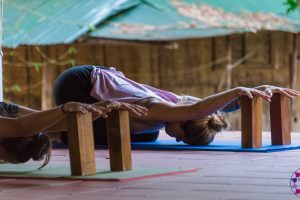The Mountain Pose

Discovering the mountain
Most of us don’t know how to stand properly. We spend our days walking and standing in closed shoes on hard concrete surfaces. This interferes with our ability to distribute our weight evenly across our feet. Our toes don’t have room to spread or our heel is often elevated, throwing our entire body out of alignment. We start holding tension in our hips or shoulders to compensate for this imbalance in our foundations. We experience aches and pains and injuries, and we attempt to correct them, but we rarely address the root of the problem.
The first time I tried yoga, I discovered that I was one of this vast majority of people who do not know how to stand properly. It was an overwhelming and humbling realization, but fortunately, my teacher also offered a solution to this fundamental problem – tadasana or the Mountain pose.
How to do tadasana
Despite being one of the most complex and challenging poses in yoga asana practice, you will rarely see pictures of tadasana on Instagram or on the cover of yoga publications (probably because it doesn’t involve balancing on one leg or twisting yourself into a pretzel). There is no room for ego in tadasana, because when done correctly, it looks as though we are simply standing still. But as with all yoga asanas, there is a lot more going on than meets the eye.
- Place your feet approximately one foot, or hip distance apart. Line up the outside edges of the feet so that they are parallel. (This may result in a slightly pigeon-toed position for some people.)
- Lift all of the toes off the ground and stretch them as far apart as possible.
- Next, stretch the big toes down and forward, pressing them into the ground. Press the centre of each heel into the ground, while keeping the smaller toes outstretched and pressing the mound of the pinkie toe down to the ground as well.
-
Click to enlarge! As you press into your foundation, you should feel your leg muscles engage and your hips and spine come into alignment. Let your awareness climb up through your body and see if you can feel:
- The calf muscle pressing down towards the heel
- The knee cap coming up
- The quads pressing to the back of the thigh
- The buttocks coming towards each other and tail bone tucking in
- The lower abdomen engaging and the side body lengthening
- The shoulders coming back and down
- The back of the head coming up towards the crown of the head. (You can tuck the chin slightly to help the back of the neck become long.)
If you cannot feel some of these action points, you made need to consciously engage that part of your body to achieve alignment. That said, in tadasana our focus should always come back to our feet. Our feet are a very advanced piece of technology – they are designed like a tripod, in order to give us maximum stability and balance. When we practice tadasana, we are relearning how to use this technology in our daily lives. Our goal is to distribute our body weight evenly over three points – the centre of the heel, the mound of the big toe and the mound of the little toe. Like a building, a human body needs a strong foundation and if the foundation is uneven, the building will start to compensate in strange and sometimes dangerous ways. When this happens, there’s no point rebuilding the walls or the roof. We must go to the source of the imbalance. We must correct the foundation.
Benefits
In yoga, tadasana is the key to all standing poses and, later on, many sitting poses as well. In this way, it is a gateway asana and when you get to grips with it, you will find greater stability and range of movement in the rest of your practice.
Off the mat, the benefits of tadasana are profound. Incorrect posture has knock-on negative effects for all physical activities, including walking, running and many types of exercise. By working towards proper alignment, we can avoid many common physical complaints, such as bad knees and tight shoulders. Plus, when we learn how to stand correctly, we align not just our musculoskeletal system, but every system in the body – our digestive, circulatory, respiratory and nervous systems all benefit from tadasana.
One of the best things about tadasana is that you can do it anywhere (without getting funny looks from the rest of the world, that is!) Try it in the office to relieve lower back pain or headaches, or even if you’re just feeling stressed. With regular practice, tadasana becomes an effective way to release tension throughout the body, giving the mind room to relax and increasing our sense of inner calm.
Beyond the asana
When I discovered tadasana, I realised what I wanted to do with my life, not just as a yoga practitioner, but in general: I wanted to go back to basics and I wanted to teach other people how to do the same. Learning to go back to basics – not just in practice, but also in life – is an essential skill. Whenever we feel a sense of imbalance or misalignment, revisiting our foundations always shows us the root of the problem. When we humble ourselves enough to practice something as simple and profound as standing up straight, we banish our ego and reconnect with our true selves, stable and unchanging.
The final goal of tadasana is to not need tadasana anymore. With enough practice, a voluntary action becomes involuntary and proper alignment will feel natural and easy. But until then, whenever we need to feel grounded and balanced, our inner mountain will always be waiting for us.




